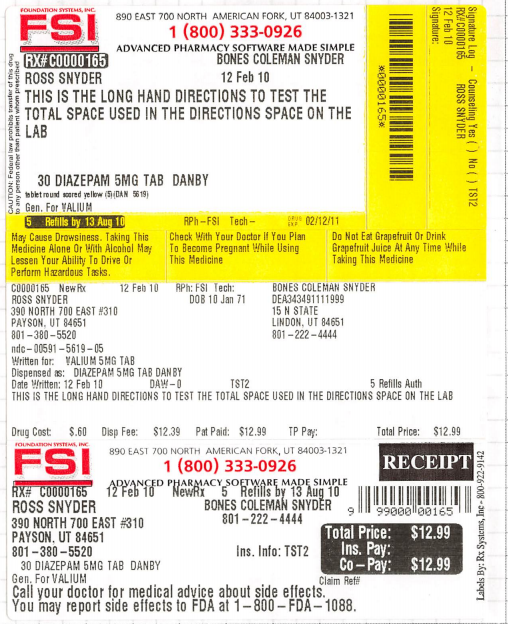
Written and published by Ross Snyder – Foundation Systems, Inc – 801-785-7720 – help.fsi.us.com
Beginning April 1st, 2015, pharmacies in the state of California have been required by their state to follow new rules about font sizes and font styles used on prescription labels. The term for this is Patient-Centered Labels. Part of the reason is to make the location of key information uniform, and the font big enough to read. The transformation started with a 10 point font, then if the customer requests larger, the pharmacy was required to print the larger 12 point font. This was ok but was difficult to configure and maintain. The law changed to require all Patient-Centered Label items to be 12 point font and in a certain order.
Under the Patient-Centered Labels requirements, the following items are REQUIRED to be in 12 point font size and must be in the below-listed order.
- Name of the patient.
- Name of the drug and strength of the drug.
- Drug manufacturer, this item must be with the drug name or immediately following the drug name on the label.
- Generic for must be spelled out “Generic for”, this can no longer be the old “Gen. For” message.
- The directions for the use of the drug.
- The purpose for which the drug was prescribed if the purpose is indicated on the prescription hard copy from the doctor.
FSI has several options available to achieve compliance using laser or thermal printers. The actual bottle label size can be a limitation. Some label formats will make the smallest bottle size you can use 13 drams. Some pharmacies are still using old label formats with very limited bottle label real estate. The Patient-Centered format can work on these, but there is no room for other necessary information.
FSI started using thermal prescription label printers sometime around 2008. At first, the technology was questionable, especially considering some patients pick up their meds and make a couple of stops on the way home. What would the heat in the car do to the label? We tested this by printing several labels. Some of the labels were applied to a pill bottle, some were not. All of the labels were put in the FSI company car in the back parking lot. The car receives sunlight almost all day and gets very hot inside during the summer. The labels not applied to a bottle were taped to the window, taking on the full sun for several hours. There was some slight fading. Since then, we have tested some of the newer labels and have had little to no fading.
If you are using one of the examples at the bottom of this post or similar, you are most likely not in compliance with the Patient-Centered requirements. This means you could be subject to warnings and fines issued by your State Board of Pharmacy. One audit gets your pharmacy time to comply, usually 30 days. If you fail to comply, the status of your license is at the mercy of the Board of Pharmacy.
California is not the only state doing this, or in the process of doing this. Here in Utah, the Board of Pharmacy tried to implement Patient-Centered Labels and backed away. California gave sufficient time for a pharmacy to use the cases of labels currently in stock before having to pick a new format and order new labels. Another issue some pharmacies faced was the old dot matrix Oki-Data printers. If you haven’t given this any thought, you should start taking a closer look.
If you would like someone else in your organization to receive The FSI 411 emails and/or update note reminders, please send me an email with their name and email address.
– Ross Snyder
I have worked a lot with thermal labels and printers over the years. I prefer thermal vs. laser mostly because of the cost. You can get rid of the big bulky laser printer when it wears out and replace it with a smaller footprint laser printer. The cost of the thermal printers made it so some pharmacies could put more printers on the counter since they were less money and a very small footprint. This helped make some pharmacies more efficient by saving pharmacy staff from walking to get a label. Time is money. The biggest thing I found was the savings in how much toner pharmacies were using. Instead of two or three toners a month for laser printers, pharmacies were down to one, maybe two, every two months. Figure that one out. The only thing to help now would be to implement a workflow that only prints the label after the pharmacist has verified the prescription. How many labels get printed for one prescription before the pharmacist gets to verify it? How full is your shredder bin? How many of you are printing the drug monograph on the label with the remains printing on extra paper? Then turn around and have to print everything again because something with the prescription changed.
For more information, post your questions at the bottom. If you live in California and you are wondering if your label meets the Patient-Centered Labels requirements, post your question and attach a test label. PLEASE, NO PHI! All comments are moderated, if I determine the information has PHI, I have to remove the comment immediately. Print a label for Mickey Mouse, or Fred Flintstone, or Test Patient, but no real people information. Last I checked, using Mickey and Fred isn’t a HIPAA violation.
Click the link below to see some of the available label formats FSI offers.
Some are Patient-Centered Label compliant.
Here are two common out-of-date thermal and laser label formats. When you click the above link, you will see these as you scroll down through the label examples. If you are using one of these and your state requires a Patient-Centered Label format, contact FSI today! FSI can help guide you in the right direction for compliance. You can also leave a comment below, I am doing my best to follow up on comments left on The FSI 411.





how do you attach a file?
Hmmm… What are you referring to?